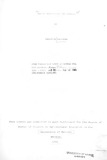| dc.description.abstract | The maize marketing system in Uganda has several problems. The official maize marketing body, the Produce Marketing Board, has been unable to effectively buy the maize from the producers.
This has beer, thought to be mainly due to its rigid pricing system of fixing pan-seasonal prices against a background of high inflation rate. The private traders who have taken on an increasing role of marketing the maize have beer, thought to be faced with a lot of problems. These include availability of working capital, transport and storage facilities. The purpose of this thesis is to describe the organization of the Uganda maize marketing system and to assess the structure, conduct and performance of the marketing system.
The primary data collected between March and May 1989 and secondary data from the relevant bodies were analysed and revealed the following results!-
Firstly, the rural-urban maize flow was mainly in the hands of the private traders who controlled more than 59 per cent of the marketed maize while the official Produce Marketing Board channel handled about 41 per cent or less. Secondly, the Produce Marketing Board pricing method restricts it from purchasing the amount of produce it would require. Thirdly, the volume of maize traded was concentrated in relatively few hands, with 10 per cent of the traders controlling 36 per cent of the maize handled. This was attributed to the existence of barriers to entry in the maize trade especially the capital required by the traders, which determined the volume of maize handled. Fourthly, it was
observed that though the markets were highly integrated price- wise, with all centres having correlation coefficients of greater than 0.6, this was due to traders' collusive tactics in influencing maize buying and selling prices to their advantage. It was further observed that traders earned profit of between 20 and 62 per cent of the marketing margin. This had the effect of either unnecessarily raising the consumer prices or affecting the rural seller, and possibly the farmer, in the form of low prices received for their maize.
For the improvement of the maize marketing system, it is recommended that the banking sector offer small traders credit facilities as this would greatly enhance their competitive position. The introduction of a dynamic market intelligence division to collect market information and inform the producers, the marketing intermediaries and consumers would go a long way in reducing the major marketing imperfections currently existing in the maize marketing system. The improvement of road conditions would also facilitate movement of produce and increase market arbitration.
The Produce Marketing Board stores that are not optimally utilized could be hired out to private traders (who have too small or poorly constructed stores) to enable them store produce which they can sell during times of scarcity. The Board could use the middle income consumer price index to adjust the maize buying and selling prices. This could then be announced either
monthly or quarterly depending on whether prices in the parallel market have changed appreciably. The Board could also use its storage facilities to maintain strategic reserves. | en_US |



